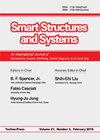Hybrid fragility curve derivation of buildings based on post-earthquake reconnaissance data
IF 2.2
3区 工程技术
Q2 ENGINEERING, CIVIL
引用次数: 1
Abstract
This study proposes a new hybrid method that uses both of post-earthquake reconnaissance data and numerical analysis results based on a finite element (FE) model. As the uncertainty of a capacity threshold for a structural damage state needs to be estimated carefully, in the proposed method, the probabilistic distribution parameters of capacity thresholds are evaluated based on post-earthquake reconnaissance data. Subsequently, the hybrid fragility curves were derived for several damage states using the updated distribution parameters of capacity thresholds. To illustrate the detailed process of the proposed hybrid method, it was applied to piloti-type reinforce concrete (RC) buildings which were affected by the 2017 Pohang earthquake, Korea. In the example, analytical fragility curves were derived first, and then hybrid fragility curves were obtained using the distribution parameters of capacity thresholds which were updated based on actual post-earthquake reconnaissance data about the Pohang city. The results showed that the seismic fragility estimates approached to the empirical failure probability at 0.27 g PGA, corresponding to the ground motion intensity of the Pohang earthquake. To verify the proposed method, hybrid fragility curves were derived with the hypothetical reconnaissance data sets created based on assumed distribution parameters with errors of 10% and 1%. As a result, it was identified that the distribution parameters accurately converged to the assumed parameters and the case of 1% error had better convergence than that of 10% error.基于震后勘察资料的建筑物混合易损性曲线推导
本文提出了一种基于有限元模型的震后勘测数据与数值分析结果相结合的混合方法。考虑到结构损伤状态容量阈值的不确定性需要仔细估计,本文提出的方法基于震后侦察数据对容量阈值的概率分布参数进行评估。随后,利用更新后的容量阈值分布参数,导出了几种损伤状态下的混合易损性曲线。为了说明所提出的混合方法的详细过程,它被应用于受2017年韩国浦项地震影响的试点型钢筋混凝土(RC)建筑。以浦项市为例,首先推导了分析型脆弱性曲线,然后利用浦项市地震后实测资料更新的承载力阈值分布参数,得到了混合脆弱性曲线。结果表明,地震易损性估计接近于0.27 g PGA的经验破坏概率,对应浦项地震的地震动烈度。为了验证所提出的方法,利用假设分布参数为10%和1%的假设侦察数据集,推导出混合易损性曲线。结果表明,分布参数准确收敛于假设参数,误差为1%的情况下收敛性优于误差为10%的情况。
本文章由计算机程序翻译,如有差异,请以英文原文为准。
求助全文
约1分钟内获得全文
求助全文
来源期刊

Smart Structures and Systems
工程技术-工程:机械
CiteScore
6.50
自引率
8.60%
发文量
0
审稿时长
9 months
期刊介绍:
An International Journal of Mechatronics, Sensors, Monitoring, Control, Diagnosis, and Management airns at providing a major publication channel for researchers in the general area of smart structures and systems. Typical subjects considered by the journal include:
Sensors/Actuators(Materials/devices/ informatics/networking)
Structural Health Monitoring and Control
Diagnosis/Prognosis
Life Cycle Engineering(planning/design/ maintenance/renewal)
and related areas.
 求助内容:
求助内容: 应助结果提醒方式:
应助结果提醒方式:


